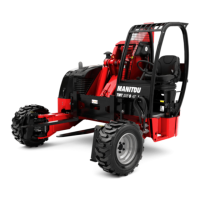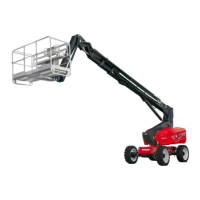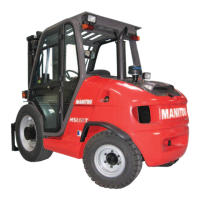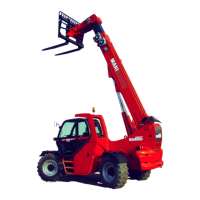1 - 19
F - PICKING UP AND SETTING DOWN A HIGH LOAD ON TIRES
IMPORTANT
You must not raise the boom if you have not checked the transverse attitude of the machine
(
INSTRUCTIONS FOR
HANDLING A LOAD: D - TRANSVERSE ATTITUDE OF THE MACHINE).
REMINDER: Make sure that the following operations can be performed with good
visibility ( OPERATING INSTRUCTIONS UNLADEN AND LADEN: D
- VISIBILITY).
PICKING UP A HIGH LOAD ON TIRES
- Ensure that the forks will easily pass under the load.
- Raise and extend the boom (1) (2) until the forks are at the level of the load. If
necessary, move the machine (3) forward (fig. F7), driving very slowly and carefully.
- Always remember to keep the distance necessary for inserting the forks under the
load, between the stack and the machine (fig. F1) and use the shortest possible
length of boom.
- Insert the forks under the load as far as they will go by alternately extending and
lowering the boom (1) or, if necessary, moving the machine forward (2) (fig. F2).
Apply the parking brake and place the forward/reverse selector in neutral.
- Lift the load slightly (1) and tilt the carriage (2) backward to stabilize the load (fig. F3).
- Tilt the load sufficiently backward to ensure its stability.
- Monitor the longitudinal stability limiter and warning device (INSTRUCTIONS FOR
HANDLING A LOAD: C - LONGITUDINAL STABILITY LIMITER AND WARNING DEVICE).
If it is overloaded, set the load back down in the place from which it was picked up.
- If possible, lower the load without moving the machine. Raise the boom (1) to
release the load, retract (2) and lower the boom (3) to set the load into transport
position (fig. F4).
- If this is not possible, reverse the machine (1), maneuvering very gently and carefully
to release the load. Retract (2) and lower the boom (3) to bring the load into the
transport position (fig. F5).
1
2
3
F1
1
2
F2
1
2
F3
1
3
2
F4
1
2
3
F5
647866 M1 (A012021)
TMT ... K ST5 S1

